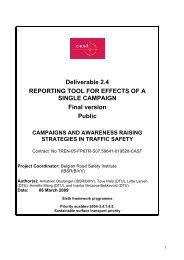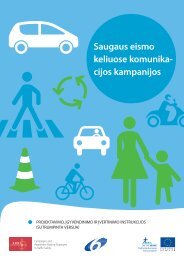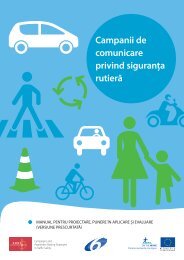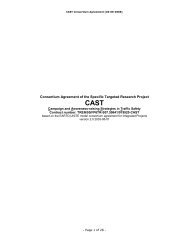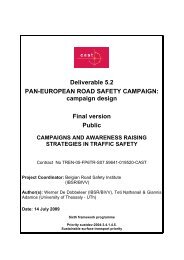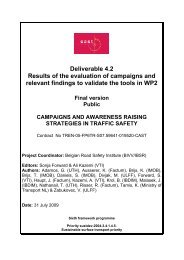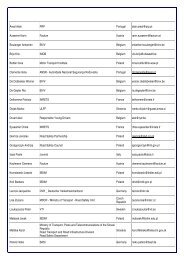Deliverable D 1.3 RESULTS OF META-ANALYSIS ... - cast-eu.org
Deliverable D 1.3 RESULTS OF META-ANALYSIS ... - cast-eu.org
Deliverable D 1.3 RESULTS OF META-ANALYSIS ... - cast-eu.org
You also want an ePaper? Increase the reach of your titles
YUMPU automatically turns print PDFs into web optimized ePapers that Google loves.
Campaigns and awareness raising strategies in traffic safety — <strong>Deliverable</strong> D-1.1Figure 8.2. Final model of relative influence of campaign factors on increasing seatbelt use.Factors in parentheses are included even though they do not appear to be significantaccording to the model, because they approach significance and have theoretical grounds tobe included.+_n<strong>eu</strong>tral• low initial seatbelt use• on-road delivery• limited area• addressing risk ofharm• (personal influence)• using humour• non-shocking consequences• use of enforcement• short duration• use of combined mass media8.3.1 CHECKS ON THE FINAL SEATBELT MODELSeveral attempts were made during development of the CAST seatbelt modelto improve its statistical properties (identify outliers, improve distributionnormality and so on). While reservations remain about the properties of themodel, as explained below, it still is considered to be a fair representation ofthe data in the CAST database.1. Checks were made for collinearity and outliers. There were indicationsof outliers (maximum Mahalanobis distance = 67), but statistical testsindicated that they did not influence the final model description unduly(maximum Cook’s Distance = 0.45). It was assumed that homoscedasticitywas minimised by weighting the regression by the fixed effects weights.2. As discussed previously, a plot of fixed effects weights vs. ln odds ratiosfor seatbelt effects shows skew. To improve the normality of distribution thosecampaign effects with odds ratios above 1.4 (6 studies) were excluded, andthe final model run on the reduced data set. The main conclusions of themodel (Figure 6.3) were the same. Concerns do remain, however, about theskewness in the normal distribution of seatbelt effects caused by the presenceof quite a few effective campaigns based on low n numbers. Attempts to treatthe effects as two groups (highly effective, small-scale campaigns versus therest) did not identify factors that were significantly influential, and so wereported the final model based on all effects.3. To further test the final model, the variable set was used to analyse thedata file after it had been split on the basis of whether initial seatbelt use wasabove (n = 66) or below (n = 67) 40 per cent. We did this because we werealso concerned about the applicability of explanatory factors drawn fromstudies with very low initial seatbelt use rates, when seat belt wearing rates109



